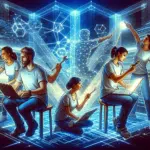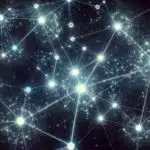Blockchain technology is advancing rapidly, opening up new possibilities for decentralized apps. As a developer, staying on top of the latest blockchain trends is essential for building innovative solutions. In this article, we dive deeper into the top 5 blockchain app development trends that will dominate in 2023.
1. Mainstreaming of Metaverse and Web3 Experiences
The metaverse and Web3 represent a new paradigm for digital experiences. These are persistent 3D virtual worlds where users can explore, socialize, play games, and conduct commerce through their digital avatars.
Blockchain technology provides the decentralized infrastructure for user-owned spaces, virtual goods, payments, and asset interoperability across the metaverse. Leading platforms like The Sandbox, and Cryptovoxels run on blockchain.
In 2023, we will see more developers create blockchain-based metaverse and Web3 apps. Use cases include:
- Virtual worlds – Persistent 3D environments where users can build virtual assets and interact through avatars.
- NFT-based gaming – Blockchain games that allow players to truly own in-game assets as NFTs.
- Decentralized social networks – Social apps with content transparency, user privacy, and digital asset ownership baked in.
- Crypto/NFT commerce – Seamless e-commerce where users can purchase real and virtual goods via crypto.
Early adoption of metaverse and Web3 capabilities will be a key competitive advantage for blockchain apps in 2023.
2. Hybrid Blockchains For Diverse Use Cases
Hybrid blockchains1 incorporate features of public and private networks. They offer the decentralization of public chains along with the access controls, efficiency and scalability of private chains.
Leading hybrid blockchain platforms like Polygon, Hyperledger Fabric, Corda, and Avalanche will gain mainstream adoption in 2023. Key benefits include:
- Best of both worlds from public and private blockchains
- High scalability and throughput
- Enterprise-grade security and privacy
- Interoperability between permissioned and public environments
We will see more enterprise blockchain apps, supply chain solutions, healthcare platforms, and government services built on hybrid chains. The configurability they provide is ideal for these use cases.
3. Off-Chain Computation to Augment On-Chain Capabilities
Performing complex computations on-chain can be prohibitively slow due to blockchain’s decentralized nature. Off-chain computation shifts computation off the main blockchain while retaining decentralization and security guarantees.
Projects like Chainlink, TrueBit and Arbitrum enable computation to happen off-chain before sending results back to the main blockchain. This approach will gain mainstream adoption in 2023.
Key benefits of off-chain computation include:
- Faster processing of heavy computations
- Cost efficiency – Less spent on gas fees
- Privacy preservation of sensitive data
- Support for compute-intensive dApps like AI/ML
As a developer, leveraging off-chain techniques will allow you to expand the capabilities of blockchain apps in 2023.
4. Interoperability for Seamless Multi-Chain Experiences
The blockchain ecosystem has grown fragmented with many isolated networks. Blockchain interoperability solutions aim to foster seamless communication and asset transfers between chains.
Interoperability protocols like Polkadot, Cosmos, RenVM and Wanchain will enable the next generation of interconnected blockchain experiences.
Key advantages include:
- Asset and data transfer between otherwise siloed blockchains
- Leveraging capabilities of different specialized chains
- Scalability through sharding2 across multiple chains
- Reduced network effects of individual chains
Developing with interoperability in mind will be crucial in 2023. This will prevent apps from being locked into single-chain limitations.
5. Evolution of NFT Utility and Capabilities
NFT uses are rapidly expanding beyond basic digital art and collectibles. In 2023, we will see the utility and capabilities of NFTs grow through innovations like:
- Metaverse integrations – NFTs that double as avatars, virtual goods and identity markers.
- Access and governance – NFTs that control access or act as voting mechanisms.
- Loyalty and rewards – NFTs used as branded loyalty badges or redeemable tokens.
- Physical asset tokenization – NFTs tied to real-world assets like real estate and commodities.
- Future interoperability – NFTs able to provide benefits across multiple ecosystems.
Focusing on adding utility will be key for NFTs in 2023 vs just creating scarce collectibles.
By staying on top of these major trends, blockchain developers can build the apps of the future and remain relevant. The pace of innovation shows no signs of slowing down. Let the era of decentralized applications begin! Contact Us!
- A Hybrid blockchain is a blockchain that combines elements of both public and private blockchains. ↩︎
- The word “Shard” means “a small part of a whole“. Hence Sharding means dividing a larger part into smaller parts. ↩︎
Posted in Blockchain, NFT, Smart Contract





